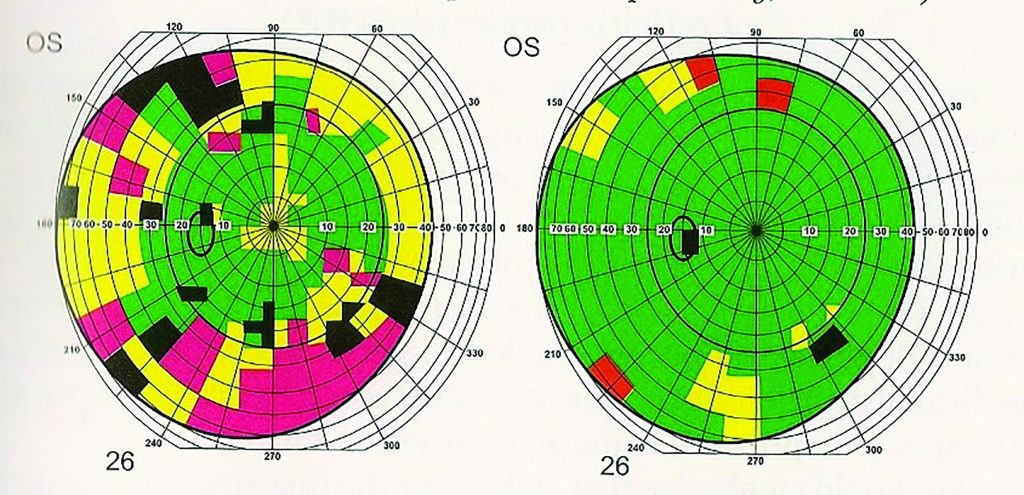
Peptide Bioregulators and Vision
May 17th, 2019An interview with Professor Svetlana Trofimova
ST: I was born into a family of doctors, so since childhood I knew that I would dedicate my life to medicine. Therefore, after graduation, I went to the St. Petersburg Pediatric Medical Institute and in 1994 I graduated with a diploma as an ophthalmologist. While still a student at the Institute, I was engaged in a scientific club at the Department of Ophthalmology, so I graduated from the Institute and went to work for the St. Petersburg Institute of Bioregulation and Gerontology, where I was able to have not only clinical practice, but also scientific work, studying the effect of peptide bioregulators on various retinal pathologies.
As a result of my scientific work, I defended two theses and now I am a Doctor of Medicine—full professor of ophthalmology and gerontology. I have participated in numerous European and World congresses on ophthalmology, gerontology and anti-aging medicine with abstracts, and I have received many awards (2002 Germany, 2003 Singapore, 2010 Moscow, etc.). I am the author of more than 150 scientific publications, 4 monographs and 4 patents. For several years I was a consultant to the pharmaceutical company BioDim, (Australia). I am the founder and President of the Russian Association of Anti-Aging Medicine, Secretary General of European Society of preventive regenerative and anti-aging medicine (ESAAM) and of the World Council for Preventive, Regenerative and Anti-Aging medicine (WOCPM). I am Deputy Director of the St. Petersburg Institute of Bioregulation and Gerontology for Clinical Work and I head one of the leading clinics in the field of anti-aging medicine the “Tree of Life” in St. Petersburg, Russia.
PM: Today, you operate one of Russia’s leading antiaging centers, based in beautiful Saint Petersburg- the Tree of Life clinic. Can you please describe some of the treatments and therapies you apply there?
ST: The scientific achievements of the St. Petersburg Institute of Bioregulation and Gerontology in the field of diagnostics and treatment of age-related pathology formed the basis for the work of the Medical Center the Tree of Life. Thus, for the first time a new type of medical institution was created, using in its work a personalized approach to each patient, based on the results of molecular-genetic testing and biological age tests.

Knowledge of such individual characteristics of the patient allows a purposeful approach to treatment and prevention of age pathology, using epigenetic activity of peptide bioregulators.
Unique medical bioregulating technologies were the basis for the programs for treating such serious conditions as complications of diabetes mellitus, osteoporosis, female urinary incontinence, macular degeneration, diabetic retinopathy, retinitis pigmentosa, prostatitis, erectile dysfunction, and prevention of signs of premature aging of the human body. Medical care is provided at all stages of the disease.
However, the greatest attention is paid to the prevention of diseases. Thus, innovative technologies based on modern diagnostics, as well as activation of the body’s own resources with the help of peptide bioregulators, allow reducing the rate of aging of the body and improving the quality of human health regardless of age.
PM: With reference to your expertise in the treatment of eyesight problems, can you please outline what kinds of cases you deal with?
ST: One of the most common problems of vision loss and blindness is the retinal degeneration. Earlier, patients with such a disease were almost doomed to blindness. The only current method for treating this pathology, developed at the St. Petersburg Institute of Bioregulation and Gerontology is used in the medical center the Tree of Life.
Let’s try to understand what retinal degeneration is and what types it has.
The retina of the eye consists of several layers, but the main part is the cones and rod cells – special photosensitive elements, through which the image is perceived by a person and then transmitted through the optic nerves to the cortex of the brain. Retinal diseases lead to atrophy (death of) cones and rod cells, that is, those elements that perceive the image, and as a result the person is blinded. Retinal injury is the most common cause of blindness. If the cones located in the center of retina are exposed to atrophy, macular dystrophy occurs, if it happens to the rod cells located on the periphery of the retina – there is peripheral (pigmentary) degeneration of the retina.
Macular dystrophy is the most common retinal disease, leading to an abrupt loss of central vision. With this disease, the central part of retina—the macula suffers. Hence the name of the disease is “macular dystrophy”. In the macula there are light-sensitive cells—cones, which provide a central vision and a color perception. Therefore, the first signs of macular dystrophy are a reduced visual acuity, a distortion of letters and lines during reading. With the progression of the disease, a spot appears before the affected eye (central scotoma). The disease is most often bilateral, only the degree of manifestation of changes in the area of the macula of both eyes is different.
Retinitis pigmentosa is a disease that is associated with atrophy of the rod cells, a retina photoreceptor responsible for peripheral black-and-white mesopic vision. People with retinitis pigmentosa usually find that they are sick, noticing the loss of peripheral vision and the ability to navigate in poorly alighted spaces. As it was, the disease is revealed in childhood or adolescence, but sometimes it can appear already in adulthood.
Diabetic retinopathy is an eye disease developing as a complication of the underlying disease – diabetes. Increased blood sugar leads to a violation of the state of blood vessels, including the vessels of the retina. Such sick vessels cause bleeding. Blood, getting into the retina and vitreous body of the eye, leads to a sharp decrease in visual acuity, up to blindness.
In the world of ophthalmology it is commonly believed that there are practically no effective methods for treating retinal degeneration and diabetic retinopathy. There are attempts to treat only certain forms of retinal degeneration and diabetic retinopathy with the help of a laser. However, this method of treatment only cauterizes the retina without affecting the causes of the development of diseases and has a number of side effects.
In the St. Petersburg Institute of Bioregulation and Gerontology, a unique method for the treatment of diabetic retinopathy and retinal degeneration was developed based on the complex application of peptide bioregulators. Thirty years of experience in the application of this method of treatment allows us to confirm the high clinical effect, as well as the complete safety of this method of treatment. This unique method we use in the Medical Center the Tree of Life.
Peptide bioregulators, used in a complex way, stimulate the activity of the organs of vision and stop the degenerative process. In addition to the retinal peptide, which has a direct effect on the cones and rod cells, we use a vascular peptide that optimizes the activity of the vascular system that supplies the eye, as well as the brain peptide that restores nerve impulses through the optic nerves. In patients with diabetic retinopathy, we additionally use a peptide that restores the pancreas and normalizes the blood sugar level. Thus, we have a health-improving effect not only on the eyes, but on the whole organism. We treat not signs of disease, but the illness itself. Only such complex approach allows not only to stop the progression of these diseases, but also to increase visual functions in humans.
PM: How successful have the peptide bioregulators been in certain cases?
ST: We have an exclusive technology for the treatment and prevention of retinal diseases such as macular degeneration, diabetic retinopathy and even retinitis pigmentosa. The only effective method of treatment of retinitis pigmentosa is developed in the St. Petersburg Institute of Bioregulation and Gerontology and is used in our clinic. Our thirty-years experience in treatment of patients with retinal pathology allows us to state good results of treatment. We manage not only to stop the progression of the pathological process, but in 80% of cases even to increase the visual functions of our patients. In addition, the complex of peptide bioregulators used in the treatment of retinitis pigmentosa, promotes retention of retinal receptors – rod cells, which allows prolonging patient ability to see for 10-15 years.
PM: Please describe a case, taking us through the experience from the patient’s point of view? I mean, can you describe how the treatment is applied and what the patient should expect or do?
ST: Depending on the disease and the stage of the pathological process, the course of treatment of patients with retinal pathology is from 25 to 30 days. Moreover, for the first 5-10 days the patient should be treated at our medical center the Tree of Life, the rest 20-25 days the patient continues the therapy course of peptides in capsules at their home. For each disease, a special scheme for the application of peptide drugs has been developed. In our medical center the Tree of Life, patients receive with the medical purpose injectable peptide bioregulators (intramuscularly, parabulbar, infusion), then treatment continues with peptide bioregulators in capsules such as, for example, Visoluten (eye peptides), Ventfort (peptides of blood vessels), Cerluten (peptides of nervous tissue) and others.
However, I want to draw your attention to the fact that the treatment should be regular. As a rule, retinal pathology is a genetically predetermined process. Peptide bioregulators do not change the structure of genes; they affect only the activity (expression) of genes. Therefore, the course of therapy should be repeated 2-4 times a year. Such a serious disease, as, for example, retinitis pigmentosa is impossible to cure completely. However, it is possible to stop the loss of vision and give the patient an additional 10-15 years of vision and quality of life!
PM: What have been some of the outstanding results?
ST: Peptide bioregulators are not hormones and not anesthetics, the results from the actions of which the doctor and patient are observed immediately. Peptide bioregulators are natural substances that are present in the body of every person, but the number of which decreases with age or as a result of the disease. Therefore, the effect of peptide bioregulators application we observe after a certain time. As an example, I want to cite one of the clinical cases. One of my first patients was the patient K., suffering from retinitis pigmentosa. In 1999 he was only 21 years old. Dystrophic eye disease began early in his life—at 12 years, so the prognosis was sad—blindness in the next 5 years. At the time of the meeting, the patient had only 10% visual acuity and 5-8% visual field. Over the next 19 years, the patient K. 4 times a year received a course of bioregulating therapy. By 2018, the patient still sees and has the healthy lifestyle!
PM: Super! We shall include some of the photos in the text for people to review. But it is exciting that the eyesight problems, including retinal pigmentosa, which is so difficult to address, are being helped so effectively.

Above: A patient treated with peptide bioregulators improves from a 30% vision impairment t(left) o a less than 5% impairment (right).
ST: For me, as the doctor, the patient’s wellness is the greatest reward!
PM: I suspect you are excited about the development of the peptide bioregulators and we have informed our readers of the long history that Russia has in dealing with them. May I ask, why do you believe they have been so efficacious when other ‘orthodox’ treatments have not fared so well?
ST: You are absolutely right, the first peptide bioregulators were developed back in the 70’s of the last century in the Military Medical Academy named after Kirov, and then at the St. Petersburg Institute of Bioregulation and Gerontology the scientists continued their study and the creation of new peptide drugs. All peptide bioregulators are patented in the Russian Federation and in the leading countries of Europe and the USA (more than 200 patents).
The first generation of peptide bioregulators were extracts from animal organs and tissues, then a new generation of peptides synthesized from amino acids in the laboratory was obtained. A modern method for obtaining such peptides is by biosynthesis, through the sequential addition of one amino acid to another. The most surprising thing is that peptides are universal bioregulators. When ingested, peptide bioregulators begin to restore the function of the organ from which they were extracted: for example, peptides from the retina restore cells only in the retina, and peptides from the cartilage cells restore cartilaginous tissue. Peptide bioregulators control the expression of genes and protein synthesis, i. e. peptides approach genes as keys to locks, interact with them and include mechanisms of protein synthesis. As a result, the full life of an organ can be increased by 30-40%. Another important feature of peptide bioregulators is that they have antioxidant and immunomodulatory effects. In addition, peptides are able to direct the differentiation of pluripotent cells in a particular direction. It is known that every organ and tissue of the body, including the retina, contains 30% of undifferentiated (or stem) cells. This allows you to use the reserve capabilities of each tissue and thus restore its function even with very severe damage.
PM: Naturally, there are many more people concerned about failing eyesight, or just the typical deterioration that most of us experience as we age. Do you have any recommend protocols for using the peptide bioregulators for such folks?
ST: If a patient’s vision loss is not subjected to severe retinal damage or cataracts, and a decrease in vision is associated with age-related presbyopia or visual fatigue, then peptide bioregulators in capsules, such as Visoluten (eye peptides), can be recommended for this patient. As a rule, to patients with presbyopia we recommend Visoluten 1 capsule 2 times a day for 30 days at least 2 times a year to improve metabolic processes in the structure of the eye and to slow the process of vision loss. Patients with visual fatigue (long-term work at the computer) in order to relieve eye strain and prevent the development of retinal pathology – Visoluten 1 capsule 1 time per day for 60 days, too, at least 2 times a year
PM: In an earlier interview I did with Professor Vladimir Khavinson, he recommended certain synergistic combinations of peptide bioregulators for different disorders. Do you have any other synergistic combinations you can recommend for eyesight?

Photo shows Professor Khavinson receiving an award from President Putin of Russia.
ST: Yes! As I have already said, only complex application of peptide bioregulators gives the best clinical effect. We treat not signs of disease, but the illness itself. Therefore, in addition to Visoluten®, Ventfort® (a vascular peptide) should be administered to patients to improve eye trophic, to improve the metabolic processes in the optic nerve. Cerluten (brain peptide), to activate the body’s defense system, Vladonix® (thymus peptide) and so on. Due to the results of many years of scientific research, we have developed special schemes for the application of peptide bioregulators, which you, Dr. Micans, know and can recommend to patients.
PM: Professor Trofimova many congratulations on your outstanding work that can bring hope to so many people. It has been wonderful to talk with you and I thank you very much for all your time today.
ST: My pleasure. Thank you too.









